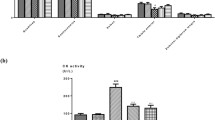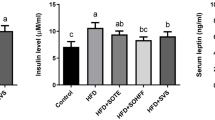Abstract
The 3-hydroxy 3-methylglutaryl coenzyme A reductase (HMG-CoA reductase) inhibitors known as “statins” are widely prescribed for the management of dyslipidemia. In spite of their muscle toxicity, use of statins has alarmingly increased worldwide. A recent report suggests that vitamin D (VD) levels are closely associated with lipid lowering activity and muscular toxicity of statins. However, data are limited and inconclusive. The present study was undertaken to investigate the effect of VD supplementation on the bioavailability and lipid lowering effect of simvastatin (ST). Adult Sprague–Dawley male rats (250 ± 10 g) were divided into four groups including control, ST (100 mg/kg/day), VD (100 μg/kg/day) and ST + VD group, respectively. After the dosing period of 8 days the animals were sacrificed and the blood was collected for the analysis of ST, its active metabolite simvastatin acid (STA), total cholesterol, triglyceride and liver enzymes including aspartate transaminase and alanine transaminase. The result of this study showed a significant decrease in the level of cholesterol and triglyceride in ST alone treated group, whereas VD alone failed to alter the blood lipid levels. Concomitant treatment with VD produced significant decrease in the bioavailability of ST and STA. However, there was no significant difference in the level of cholesterol in ST alone and in ST + VD treated group. Our results on the liver enzyme suggest that ST alone or in combination with VD does not produce any hepatotoxicity. Further studies using VD along with various statins for a longer duration are suggested.


Similar content being viewed by others
References
Ahmed W, Khan N, Glueck CJ, Pandey S, Wang P, Goldenberg N et al (2009) Low serum 25 (OH) VD levels (<32 ng/ml) are associated with reversible myositis-myalgia in statin-treated patients. Transl Res 153:11–16
Aikawa M, Rabkin E, Sugiyama S, Voglic SJ, Fukumoto Y, Furukawa Y, Shiomi M et al (2001) An HMG-CoA reductase inhibitor, cerivastatin, suppresses growth of macrophages expressing matrix metalloproteinases and tissue factor in vivo and in vitro. Circulation 103:276–283
Al-Otaibi KE, Al Elaiwi AM, Tariq M, Al-Asmari AK (2012) Simvastatin attenuates contrast-induced nephropathy through modulation of oxidative stress, proinflammatory myeloperoxidase, and nitric oxide. Oxid Med Cell Longev 2012:831748
Arnaud C, Braunersreuther V, Mach F (2005) Towards immunomodulatory and anti-inflammatory properties of statins. Trends Cardiovasc Med 15:202–206
Asghar O, Alam U, Hayat SA, Aghamohammadzadeh R, Heagerty AM, Malik RA (2012) Obesity, diabetes and atrial fibrillation; epidemiology, mechanisms and interventions. Curr Cardiol Rev 8(4):253–264
Barthe L, Woodley J, Houin G (1999) Gastrointestinal absorption of drugs: methods and studies. Fundam Clin Pharmacol 13(2):154–168
Bell DS (2010) Resolution of statin-induced myalgias by correcting VD deficiency. South Med J 103:690–692
Bhattacharyya S, Bhattacharyya K, Maitra A (2012) Possible mechanisms of interaction between statins and VD. QJM 105(5):487–491
Carlucci G, Mazzeo P, Biordi L, Bologna M (1992) Simultaneous determination of simvastatin and its hydroxy acid form in human plasma by high-performance liquid chromatography with UV detection. J Pharm Biomed Anal 10(9):693–697
Cassel I (2013) The Horrors of Statin Drugs: The Misguided War on Cholesterol, http://www.proliberty.com/observer/20071001.htm. Accessed 11 Aug 2013
Chan L, Lowes S, Hirst BH (2004) The ABCs of drug transport in intestine and liver: efflux proteins limiting drug absorption and bioavailability. Eur J Pharm Sci 21(1):25–51
Chow EC, Durk MR, Cummins CL, Pang KS (2011) 1α, 25-DihydroxyVD3 up-regulates P-glycoprotein via the VD receptor and not farnesoid X receptor in both fxr (−/−) and fxr (+/+) mice and increased renal and brain efflux of digoxin in mice in vivo. J Pharmacol Exp Ther 337(3):846–859
Christians U, Strom T, Zhang YL, Steudel W, Schmitz V, Trump S, Haschke M (2006) Active drug transport of immunosuppressants: new insights for pharmacokinetics and pharmacodynamics. Ther Drug Monit 28(1):39–44
Duell PB, Connor WE (2008) Abstract 3701: VD deficiency is associated with myalgias in hyperlipidemic subjects taking statins. Circulation 118:S470
Ebrahim S, Casas JP (2012) Statins for all by the age of 50 years? Lancet 380(9841):545–547
Eloranta JJ, Hiller C, Jüttner M, Kullak-Ublick GA (2012) The SLCO1A2 gene, encoding human organic anion-transporting polypeptide 1A2, is transactivated by the VD receptor. Mol Pharmacol 82(1):37–46
Fromm MF, Busse D, Kroemer HK, Eichelbaum M (1996) Differential induction of prehepatic and hepatic metabolism of verapamil by rifampin. Hepatology 24(4):796–801
Fukumoto Y, Libby P, Rabkin E, Hill CC, Enomoto M, Hirouchi Y, Shiomi M (2001) Statins alter smooth muscle cell accumulation and collagen content in established atheroma of watanabe heritable hyperlipidemic rabbits. Circulation 103:993–999
Garcia MJ, Reinoso RF, Sanchez Navarro A, Prous JR (2003) Clinical pharmacokinetics of statins. Methods Find Exp Clin Pharmacol 25(6):457–481
Ginter E, Simko V (2009) Statins: the drugs for the 21st century? Bratisl Lek Listy 110(10):664
Goldstein MR, Mascitelli L, Pezzetta F (2009) Statin therapy, muscle function and VD. QJM 102(12):890–891
Grimes DS (2009) Statins and vitamin D. Cardiovasc Drugs Ther 23(4):261–262
Gruer PJ, Vega JM, Mercuri MF, Dobrinska MR, Tobert JA (1999) Concomitant use of cytochrome P450 3A4 inhibitors and simvastatin. Am J Cardiol 84(7):811–815
Hashizume T, Xu Y, Mohutsky MA, Alberts J et al (2008) Identification of human UDP-glucuronosyltransferases catalyzing hepatic 1α, 25-dihydroxyVD < sub > 3 </sub > conjugation. Biochem Pharmacol 75(5):1240–1250
Ho RH, Kim RB (2005) Transporters and drug therapy: implications for drug disposition and disease. Clin Pharmacol Ther 78(3):260–277
Holick MF (2007) Vitamin D deficiency. N Engl J Med 357(3):266–281
Holtbecker N, Fromm MF, Kroemer HK, Ohnhaus EE, Heidemann H (1996) The nifedipine-rifampin interaction. Evidence for induction of gut wall metabolism. Drug Metab Dispos 24(10):1121–1123
Holtzman CW, Wiggins BS, Spinler SA (2006) Role of P-glycoprotein in statin drug interactions. Pharmacotherapy 26(11):1601–1607
Huhle G, Abletshauser C, Mayer N, Weidinger G, Harenberg J, Heene DL (1999) Reduction of platelet activity markers in type II hypercholesterolemic patients by a HMG-CoA-reductase inhibitor. Thromb Res 95:229–234
Jasiñska M, Owczarek J, Orszulak-Michalak D (2007) Statins: a new insight into their mechanisms of action and consequent pleiotropic effects. Pharmacol Rep 59(5):483
Jerling M, Huan BL, Leung K, Chu N, Abdallah H, Hussein Z (2005) Studies to investigate the pharmacokinetic interactions between ranolazine and ketoconazole, diltiazem, or simvastatin during combined administration in healthy subjects. J Clin Pharmacol 45(4):422–433
Joy TR, Hegele RA (2009) Narrative review: statin-related myopathy. Ann Intern Med 150(12):858–868
Kanathur N, Mathai MG, Byrd RP Jr, Fields CL, Roy TM (2001) Simvastatin-diltiazem drug interaction resulting in rhabdomyolysis and hepatitis. Tenn Med 94(9):339–341
Kantola T, Kivistö KT, Neuvonen PJ (1998) Erythromycin and verapamil considerably increase serum simvastatin and simvastatin acid concentrations. Clin Pharmacol Ther 64(2):177–182
Karlgren M, Vildhede A, Norinder U et al (2012) Classification of inhibitors of hepatic organic anion transporting polypeptides (OATPs): influence of protein expression on drug–drug interactions. J Med Chem 55(10):4740–4763
Khandwala HM (2006) Lipid lowering inefficacy of high-dose statin therapy due to concurrent use of phenytoin. South Med J 99(12):1385–1387
Kiernan TJ, Rochford M, McDermott JH (2007) Simvastatin induced rhabdomyolysis and an important clinical link with hypothyroidism. Int J Cardiol 119(3):374–376
Kivistö KT, Niemi M, Schaeffeler E et al (2004) Lipid-lowering response to statins is affected by CYP3A5 polymorphism. Pharmacogenet Genomics 14(8):523–525
Kolars JC, Schmiedlin-Ren P, Schuetz JD, Fang C, Watkins PB (1992) Identification of rifampin-inducible P450IIIA4 (CYP3A4) in human small bowel enterocytes. J Clin Invest 90(5):1871–1878
Kyrklund C, Backman JT, Kivistö KT, Neuvonen M, Laitila J, Neuvonen PJ (2000) Rifampin greatly reduces plasma simvastatin and simvastatin acid concentrations. Clin Pharmacol Ther 68(6):592–597
Laufs U, La Fata V, Plutzky J, Liao JK (1998) Upregulation of endothelial nitric oxide synthase by HMG CoA reductase inhibitors. Circulation 97:1129–1135
Laufs U, Marra D, Node K, Liao JK (1999) 3-Hydroxy-3-methylglutaryl-CoA reductase inhibitors attenuate vascular smooth muscle proliferation by preventing rho GTPase-induced down-regulation of p27(Kip1). J Biol Chem 274:21926–21931
Lee P, Greenfield JR, Campbell LV (2009) Vitamin D insufficiency–a novel mechanism of statin-induced myalgia? Clin Endocrinol 71(1):154–155
Liao JK (2007) Safety and efficacy of statins in Asians. Am J Cardiol 99(3):410–414
Lilja JJ, Kivistö KT, Neuvonen PJ (1998) Grapefruit juice—simvastatin interaction: effect on serum concentrations of simvastatin, simvastatin acid, and HMG-CoA reductase inhibitors. Clin Pharmacol Ther 64(5):477–483
Lozano R, Naghavi M, Foreman K, Lim S, Shibuya K, Aboyans V, Dabhadkar KC (2013) Global and regional mortality from 235 causes of death for 20 age groups in 1990 and 2010: a systematic analysis for the Global Burden of Disease Study 2010. Lancet 380(9859):2095–2128
Maxa JL, Melton LB, Ogu CC, Sills MN, Limanni A (2002) Rhabdomyolysis after concomitant use of cyclosporine, simvastatin, gemfibrozil, and itraconazole. Ann Pharmacother 36(5):820–823
Moyer MW (2012) The stats on statins: should healthy adults over 50 take them? http://www.scientificamerican.com/article.cfm?id=statins-should-healthy- adults- over-50- take- them. Accessed 11 Aug 2013
Neuvonen PJ, Niemi M, Backman JT (2006) Drug interactions with lipid lowering drugs: mechanisms and clinical relevance. Clin Pharmacol Ther 80(6):565–581
Patel BN, Sharma N, Sanyal M, Shrivastav PS (2008) Simultaneous determination of simvastatin and simvastatin acid in human plasma by LC-MS/MS without polarity switch: application to a bioequivalence study. J Sep Sci 31(2):301–313
Pe′rez-Castrillo′n JL, Abad Manteca L, Vega G, Del Pino Montes J, de Luis D, Duenas A (2010) Vitamin D levels and lipid response to atorvastatin. Int J Endocrinol 2010:320721
Prueksaritanon T, Subramanian R, Fang X, Ma B, Qiu Y, Lin JH, Baillie TA (2002) Glucuronidation of statins in animals and humans: a novel mechanism of statin lactonization. Drug Metab Dispos 30(5):505–512
Prueksaritanont T, Gorham LM, Ma B, Liu L, Yu X, Zhao JJ, Vyas KP (1997) In vitro metabolism of simvastatin in humans (SBT) identification of metabolizing enzymes and effect of the drug on hepatic P450s. Drug Metab Dispos 25(10):1191–1199
Reiner Z, Catapano AL, Backer GD, Graham I, Taskinen MR, Wiklund O et al (2011) ESC/EAS Guidelines for the management of dyslipidaemias. The task force for the management of dyslipidaemias of the European Society of Cardiology (ESC) and the European Atherosclerosis Society (EAS). Eur Heart J 32:1769–1818
Ridker PM, Rifai N, Pfeffer MA, Sacks FM, Moye LA, Goldman S, Flaker GC (1998) Inflammation, pravastatin, and the risk of coronary events after myocardial infarction in patients with average cholesterol levels. Cholesterol and recurrent events (care) investigators. Circulation 98:839–844
Sadeghi R, Adnani N, Erfanifar A, Gachkar L, Maghsoomi Z (2013) Premature coronary heart disease and traditional risk factors-can we do better? Int Cardiovasc Res J 7(2):46–50
Schwartz JB (2009) Effects of VD supplementation in atorvastatin-treated patients: a new drug interaction with an unexpected consequence. Clinical Pharmacol Ther 85(2):198–203
Smith NF, Acharya MR, Desai N, Figg WD, Sparreboom A (2005) Identification of OATP1B3 as a high-affinity hepatocellular transporter of paclitaxel. Cancer Biol Ther 4(8):815–818
Sugimoto KI, Ohmori M, Tsuruoka S et al (2001) Different effects of St John’s wort on the pharmacokinetics of simvastatin and pravastatin. Clin Pharmacol Ther 70(6):518–524
Trialists CT (2012) The effects of lowering LDL cholesterol with statin therapy in people at low risk of vascular disease: meta-analysis of individual data from 27 randomised trials. Lancet 380(9841):581–590
Ucar M, Neuvonen M, Luurila H, Dahlqvist R, Neuvonen PJ, Mjörndal T (2004) Carbamazepine markedly reduces serum concentrations of simvastatin and simvastatin acid. Eur J Clin Pharmacol 59(12):879–882
Vickers S, Duncan CA, Vyas KP, Kari PH, Arison B, Prakash SR, Duggan DE (1990) In vitro and in vivo biotransformation of simvastatin, an inhibitor of HMG CoA reductase. Drug Metab Dispos 18(4):476–483
Walley T, Folino-Gallo P, Stephens P, Van Ganse E (2005) Trends in prescribing and utilization of statins and other lipid lowering drugs across Europe 1997–2003. Br J Clin Pharmacol 60(5):543–551
Ware WR (2010) The JUPITER lipid lowering trial and VD: is there a connection? Dermatoendocrinology 2(2):50–54
Yeter E, Keles T, Durmaz T, Bozkurt E (2007) Rhabdomyolysis due to the additive effect of statin therapy and hypothyroidism: a case report. J Med Case Rep 1:130
Author information
Authors and Affiliations
Corresponding author
Rights and permissions
About this article
Cite this article
Al-Asmari, A.K., Ullah, Z., Al-Sabaan, F. et al. Effect of vitamin D on bioavailability and lipid lowering efficacy of simvastatin. Eur J Drug Metab Pharmacokinet 40, 87–94 (2015). https://doi.org/10.1007/s13318-014-0183-z
Received:
Accepted:
Published:
Issue Date:
DOI: https://doi.org/10.1007/s13318-014-0183-z




